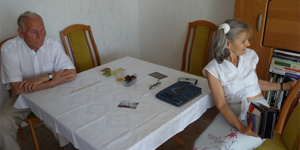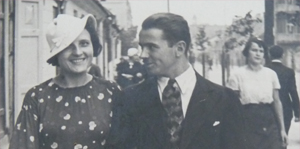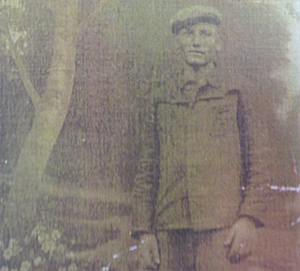In this third part of our series in honour of Remembrance Day, Katy Carr travels to Gdansk in Poland to meet the man who inspired her song, ‘Kommander’s Car’, with his bold escape from Nazi concentration camp Auschwitz in 1942. Welcomed into his home, she finds that Kazimierz Piechowski’s life story is even more incredible and touched with profound sadness than even she had imagined. (The first two instalments are here and here.)

* * *
After arranging to travel to Gdansk in August 2009, I started to prepare my thoughts and questions. I wanted to find out about Kazik as a person, his early life, why the Nazis transported him to Auschwitz, what happened after his escape, and to talk about the song. Kazik and Iga had given me permission to film the visit with a view to eventually piecing together a documentary, which we would then submit to the Imperial War Museum for their short film festival taking place a few months later. Arriving at the airport in Gdansk with Hannah Lovell, who would direct the documentary, and Benedictus Zazadski, who would be our cameraman, we were met by a musician friend of mine, Jacek Kulesza, who had kindly offered us a place to stay at his flat, 20 minutes’ walk from the centre of the city.
I wanted to meet Kazik immediately on the afternoon we arrived, firstly with no cameras as I felt this would be most sensitive, so we quickly dropped off our stuff and set out. In contrast to the very Eastern European, grey concrete townhouse we were staying in, Kazik and Iga’s home was in a modern development, a block of about 10 floors brightly painted pastel pink and yellow on the outside, with a beautiful hedged garden. To say that we were greeted in a very welcome manner doesn’t do justice to either Kazik or Iga. Dressed very smartly in summer clothes, Kazik looked barely into his 70s rather than the 90 year old man we were expecting, while Iga, dressed stylishly and wearing a pair of her beloved high heels, could have passed for 20 years younger than her comparatively modest 70 years.
The first thing we noticed about their home was that it was absolutely pristinely clean. You got the sense that everything had its proper place (we later learned that Iga is an officious organiser who catalogues everything) and there were very few trinkets on display. If it at first seemed a little unusual for an elderly couple to live so modestly and cleanly, without clutter, it made perfect sense later. The walls, too, were sparse. A painting of Nefertiti on papyrus shows their love for travel (Kazik has visited over 60 countries), while a stunning wood-carved wall hanging of the Gdansk Crane (Zuraw) building displays a faithfulness to his home town. I was shocked by one of the other pictures; a painting of Jesus on the cross peppered with bullet holes, with potatoes and a knife strewn at his feet on the ground, I found it unnerving and a little incongruent with the surroundings. It was a gift to Kazik from an artist, Iga explained, and was based on an old Polish metaphor for an impossible decision. It’s like, do you choose faith and good, or do you choose sustenance and life? “There is no choice,” she tutted.
In the dining room, Iga had prepared a large supper of traditional Polish food including pickled herring, polish sausages, cheeses and salad, finishing it off with poppy seed cake (my favourite) and a much needed coffee, served in a delicate and beautiful crimson and gold 1930s tea set. Before sitting to eat we had a chat about why we had wanted to come from England to visit him. Both Hannah and I were struck by how intensely Kazik was gazing at us. It was if he was reading our minds, or looking straight through us with his crystal green eyes. It was a look that told me instantly that this was somebody highly tuned into human emotions and one you couldn’t fool. It would be total truth or nothing, no middle ground.
Kazik and Iga both eat very daintily, taking small bites and always with very gracious manners. I was struck by how dignified they were, how everything they did and said seemed to come from a very high point of honour. I asked Iga about her teaset, wanting to know where she got it from. “This was my mother’s,” she smiled. “She gave it to me for my wedding present. She hid it in our house cellar during the war. The Nazis came to our town and threw my family, including myself as a very young baby, in a concentration camp because they wanted to live in our house. Mother had half a slice of hard black bread to feed me in the camp. She used to spit on the bread to moisten it. When I was 18 months old I weighed only five kilos.”

Iga’s parents before the war
I had read about similar stories in the accounts of other concentration camp survivors, but to hear it in person from the very slim, sharp woman in front of me had a huge emotional impact, and I wondered whether being starved as a baby was the reason she had such a tiny frame even now. They certainly ate well; their kitchen cupboards were filled to the brim, and outside in their garage – next to Kazik’s 20 year old Toyota Pony, “my Oldie” – are stacked gallons and gallons of carrot juice. Kazik’s mother, I later found out, lost all her worldly possessions in a very similar manner to Iga’s family. Barging into her home while she was doing the dishes, the Nazis barked at her to answer whether she was Polish or German. When she replied that she was Polish, they forcefully handcuffed her and sent her to work (and live) in a cow stable in Germany for 6 years. She was one of the lucky ones.
In the dining room I noticed twenty or so books on Auschwitz tucked neatly away but still on show. I wanted to ask Kazik why he kept these reminders in view, but before I could say anything he Kazik began to share a story with us about his time in the camp. He remembered the Nazis and SS officers whipping people, naked, to the ‘Wall of Death’ to be shot. If a baby cried, he said, “the murdering bastards” would drop it into a canvas bag then bash the child against the wall until it cried no further, then they’d throw it onto the pile of dead bodies. One of Kazik’s jobs in the camp was in the work commando charged with loading the bodies onto a cart and taking them to the crematorium for burning. “There were three pairs of us,” he explained. “The prisoner opposite would take the hands and I the feet, and then onto the cart. The hands, the feet, on the cart; we worked 16 hours a day.” Incredibly, one of the men in the same commando is still alive and remains good friends with Kazik; the two men see each other as brothers, he explained.
When we left that evening we were respectfully shaken and reminded that the rest of our visit would be a very moving and highly charged visit. In the morning I prepared my questions for the day. I would start by playing Kazik my song, ask him how he came to be in Auschwitz, his experiences there, and about the escape. First, though, Kazik gave us a lesson in how to make a good Polish breakfast, crunching up some walnuts and adding them to cornflakes together with a pot of set yoghurt and some mountain honey, stirring it in a very particular way. It tasted divine! Finally we were ready and gathered around the stereo.
In the first few seconds of hearing the song Kazik ordered us to stop and restart it – “This song cannot be played too quietly, it has to be loud!” he exclaimed. I watched his face intently as the song played again. At this point I knew he didn’t fully understand my English words, only my Polish lyrics, and that I would have to translate what I had written about on the next listen. Even so, he seemed to instinctively know what I was saying in the song. Seeing him react and cry when the song reached the climax, the escape, was tearful for me too because I knew he understood what I was singing about. We all needed tissues by the time it finished.
After we’d composed ourselves Kazik said, “Bravo Katy. When I listen to this song I am there, in Auschwitz, not here. The song starts and you can hear the drama growing, a very deep drama, but it says just wait a little, more is coming. The climax is where I can hear the priest saying in my ear ‘Kazik! Do something!’; I realise that they are all counting on me. Then I see the barrier going to the top, and we drive away to our freedom. Little by little the drama and the music calms down as we drive away. Katy, where did you get this insight from, who gave you this?” he asked. “You sang our own Polish words that grabbed our hearts,” added Iga. “We don’t understand all the lyrics but…the music and the melody speaks to us.” I explained that I saw Kazik as a bird, to which he replied, “The music is the deep drama and the words are philosophy.”

Kazik, age 22, just after he escaped from Auschwitz in the Kommander’s car
Beginning our interview in earnest, I asked Kazik how he had ended up in Auschwitz as a Polish political prisoner. “The Second World War started on September 1, 1939; on September 4, the Germans were in Tczew, my hometown, near Gdansk. There they took civil servants, doctors, priests, teachers and scouts to the main square and shot them. That was it. There is now a stone in Municipal Park, Tczew, commemorating those scouts that were shot. One of them, Jurgo, was my very best friend. He was shot trying to save other scouts who were trying to escape. You may ask why girl and boy scouts? Because we were patriots, our hearts were in Poland. I didn’t want to be shot so I escaped with my friend Alec. We hoped to escape to Hungary and France, to go out of the town, go through the forest, down the valley and up the slope to the border and be sorted, but it didn’t work out.”
Just a short way down the road, Kazik and Alec were caught. “A couple of SS men on motorbikes came roaring round the corner. They said to us, ‘From Tczew, near Gdansk? What are you doing here? There’s no discussion here. You’re coming with us to the Gestapo headquarters.” There they beat Alec so badly I hardly recognised him; I couldn’t see his lips, his eyes. He eventually told them that we were trying to make it to the border. I told him, ‘Good, you told them, or they would have killed you’.” The next day the Gestapo told Kazik, ‘We know now you wanted to go over the border. We were meant to shoot you but we have something better for you than being shot’. “I thought what could be better than being shot?’” he shrugged. For the next eight months Kazik was taken through about eight Nazi jails before finally being transported to Auschwitz on June 20, 1940. Arriving at the camp, he realised with horror that this must have been what the Gestapo had meant. “This hell, Auschwitz, was better than being shot? They knew that Auschwitz would exist all those months ago.”
Kazik told me about living with the psychological phenomenon of Auschwitz syndrome, how he is still plagued by nightmares of being chased by SS men with dogs, of seeing atrocities in the camp, of the starvation, the murder, the abject cruelty, the beatings, the death, the smells, the ’standing cells’ where prisoners had to stand up all night as a form of torture. Some suffocated, others went mad, he said. He told me about having to work 16 hours a day hard labour with only starvation rations for energy. He told me a game the SS men used to play, in which they would throw a prisoner’s hat towards the electric fence before ordering him to pick it up. They would then shoot the man dead just so they could get three days’ holiday for preventing an ‘escape’.
With such a threat hanging over their heads and scenes of indelible evil everywhere they looked, the desire to somehow break out of Auschwitz must have been all-consuming. When Genek first suggested the idea of simply driving out in the Kommander’s car, Kazik was convinced it wouldn’t work. As he explains, “Genek was a first class mechanic who worked in the SS garage. He was to be on be next on the death list and so was desperate to escape. I thought he was talking crazy nonsense until he said that he could arrange to get a car. I knew where the SS uniforms were, so we organised a fictitious work commando to get out of the central compound to the SS garage on a Saturday when the SS took a holiday.”
Kazik describes the car, a Steyr 220, as a dark-coloured hard-top, and to this day sees the vehicle as “A very close friend, a brother. It carried us to safety, it carried us away.” As he recalls, Genek knew it was the fastest car around. “The Kommander had to have a fast car, he had to be in Berlin within two hours for meetings, so it was fast! The problem was that we had no documents, and that was our worry. We planned to kill ourselves if we couldn’t make it through the final gate. We didn’t want to kill any Germans knowing that the retribution on the rest of the camp would be horrific.” The sense of elation they felt once outside the gates of Auschwitz was indescribable, though inevitably mixed with deep regret for having left so many comrades behind. Kazik doesn’t speak much about the minutes immediately after the escape; probably the blood was rushing through his head so fast that retaining a clear sequence of events would be impossible. The story picks up as the four men made it to the mountains. “As we were driving higher and higher the road was getting narrower and narrower. Eventually we knew we’d have to abandon the car and proceed on foot. When eventually that happened I took two steps and said goodbye to the car, my friend.”
* * *
Find out what happened to Kazik next in tomorrow’s final instalment of Kazik, Katy & The Kommander’s Car.
